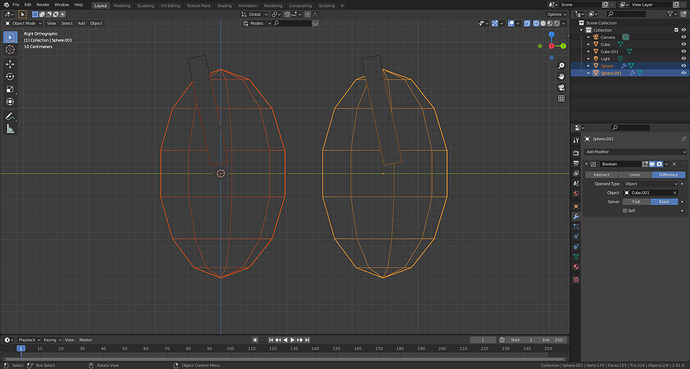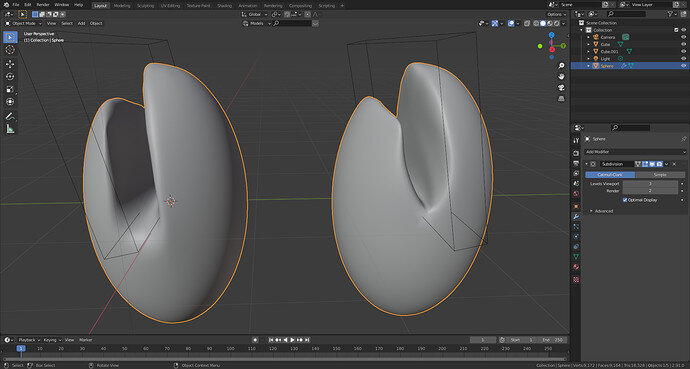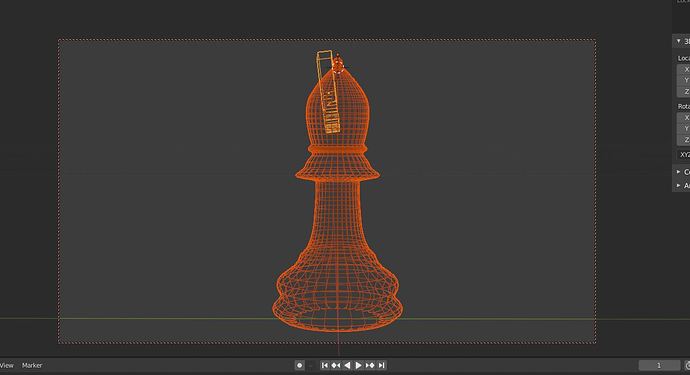I haven’t found a solution to smooth the bishop, I use the mean crease for a clean look, but if I don’t use it then the look of my piece is broken…, how can I make a perfect ‘Smooth’ without using the mean crease please?
Thanks for reading 
The problem with boolean subtract is that it also creates unwanted mesh definitions, like triangles or polygons. It is a good habit, to see (to predict) how Blender will cut faces. Fewer triangles, fewer polygons (faces with more than 4 vertices) and fewer vertices grouped close together.
This depends on where you place the cutout object (don’t place it randomly, but strategically)
The modifier has some options to choose from and manipulate, like Solver FAST/EXACT. But most of the time you need to clean up manually the object mesh. Making polygons quads and or triangles.
And there are other more experienced options, like retopology. Creating the mesh in shape, but also on a more suitable, cleaner and smoother design. In short, it is a complex step in modeling, practice and study.
There is also a paid plug-in that is very good at cutting strange objects.
Can you show us an example where the smooting goes wrong?
Thank you very much for your feedback,
I’ll look into it, and here is a rendering without using the mean crease
Position substract object
Left side better less faces touched
Clean up
Right side after substraction, show a poly gon, a face with more then 4 vertices. Which is doable, but should be manually cleaned as shown on the left side (3 x Quads (faces with 4 vertices)
Smoothing, using subdivision
The right side, with polygon, has a minor artifact. It can be worse, all depending on the rest of the mesh cleanliness.
Thank you very much for all these explanations, I finally understood thanks to you, I will be very careful with my cuttings, I understand well the interest to work also in Wire ahah
Thank you for the time you gave me 
I have a small question, if we work with the boolean, in a general way we must use it for low poly rather? or is it possible to make good substruction (remove material) in high poly?
With my bishop for example 
ps: sorry for my english, I’m learning the language :s
If the bishop has a high density of the mesh, meaning a high amount of faces. Then of course a lot of strange unwanted faces (triangles, quad and polygons) are created using a boolean. And if these faces are very tiny, you can not see these imperfections, resulting in a smooth surface.
But zoomed in, then it could be a different story.
You can compare it with Minecraft. in front of the view blocky designs. But in the distance, more fluid, less blocky.
The boolean modifier can be used in low and high poly models!
But high poly models are difficult to manipulate and to clean up after the boolean. And deliver slow render calculations. Important for games and movies. This is a problem when objects have massive mesh data (faces).
We want to strive for the optimum. As much data as we need to make it look (perform) good.
Working with high poly models is mostly done with sculpting tools. And the process of sculpting has also a process of bringing the High poly over to a low poly model. With material and textures extracted from the high poly model. Projected on the low poly model.
This chess set challenge is to learn basic Blender tools and tricks. The reason for low poly is to, you as a student, learn to work on a simple understandable object. Increasing the difficulties each time a bit. The Knight is also next level. It is better to follow along with the teacher and learn the basic blender concepts.
And yes, some students are doing much more (high poly). But not everybody has the same knowledge level and can participate on problems.
Higher poly has other options like the great different way used by another poster.
Thank you very much for all the explanations, there are so many people who have obtained a smooth result that I thought I just didn’t understand anything…
now I’m reassured 
Thank you very much for your feedback

We all have this moment! How did they do that … how to create such high-end illustrations … it all starts with basic Blender knowledge. And build up from that knowledge. Just have fun, do the challenges, even if you don’t like the subject. Sometimes you don’t see the reason for it. And then… suddenly things fall together.







